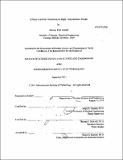Silicon carbide oxidation in high temperature steam
Author(s)
Arnold, Ramsey Paul
DownloadFull printable version (15.22Mb)
Other Contributors
Massachusetts Institute of Technology. Dept. of Nuclear Science and Engineering.
Advisor
Mujid S. Kazimi.
Terms of use
Metadata
Show full item recordAbstract
The commercial nuclear power industry is continually looking for ways to improve reactor productivity and efficiency and to increase reactor safety. A concern that is closely regulated by the Nuclear Regulatory Commission is the exothermic zircaloy-steam oxidation reaction which can potentially occur during a loss of coolant accident (LOCA), and may become autocatalytic beyond 1,200 0C, thus generating a large amount of hydrogen. The concern for the zircaloy oxidation reaction has been heightened since the March 2011 events of Fukushima, Japan. One solution offering promising results is the use of silicon carbide (SiC) cladding in nuclear reactor fuel rod designs. SiC, a robust ceramic which reacts very slowly with water or steam, has many features that meet or exceed that of zircaloy including the ability to withstand higher temperatures due to a higher melting point and the ability to absorb fewer neutrons than zircaloy which would allow for increased safety margins and fuel burnup. An experimental investigation of the oxidation performance of a-SiC during a postulated LOCA event was performed. The test facility was designed and fabricated to test the oxidation rates of zircaloy and SiC in a high temperature, high-purity, flowing steam environment. Studies of zircaloy-4 oxidation were conducted to validate the test facility for this purpose. Thirty six zircaloy-4 tests lasting up to 30 minutes, at temperatures ranging from 800°C to 1,200°C, were completed and compared to existing models and literature data. Additionally, six longer duration a-SiC tests lasting from 8 hours to 48 hours, at temperatures of 1,140°C and 1,200°C, were completed. These tests clearly show that, from an oxidation perspective, SiC significantly outperforms zircaloy in high-flowing, superheated steam. For zircaloy, results from the most intense temperature/duration testing combination of 1,200°C for 30 minutes show 15.6 percent weight gain. For the most intense SiC tests at 1,200°C for eight hours, a weight loss of two orders of magnitude less occurred, a 0.077 percent weight loss. The four 24 hour and 48 hour SiC tests at 1,140°C also correlate well with the expected paralinear oxidation trend and further confirm that SiC is more resistant to oxidation in high temperature steam than zircaloy.
Description
Thesis (S.M.)--Massachusetts Institute of Technology, Dept. of Nuclear Science and Engineering, 2011. Cataloged from PDF version of thesis. Includes bibliographical references (p. 119-123).
Date issued
2011Department
Massachusetts Institute of Technology. Department of Nuclear Science and EngineeringPublisher
Massachusetts Institute of Technology
Keywords
Nuclear Science and Engineering.